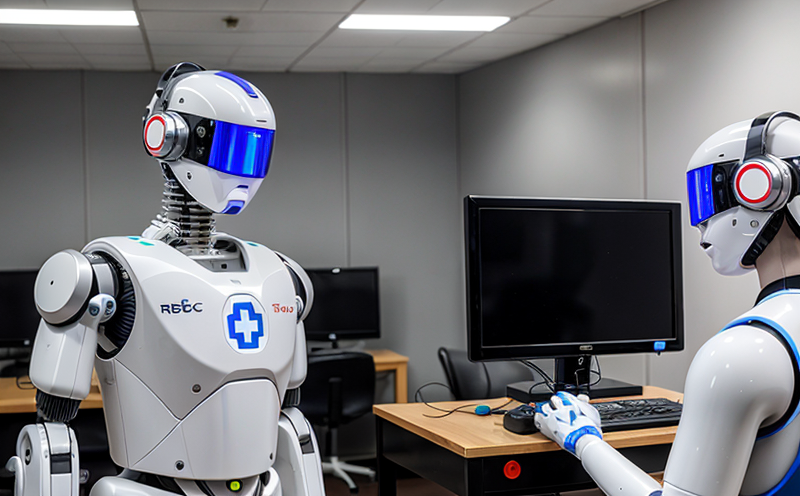ANSI/UL 1740 Industrial and Service Robot Safety Testing
The ANSI/UL 1740 standard is a comprehensive set of guidelines designed to ensure the safety of industrial and service robots, which are increasingly integrated into modern manufacturing processes. This standard addresses multiple aspects of robot design, manufacture, installation, operation, and maintenance, providing a framework for reducing risks associated with robotic systems.
Industrial and service robots operate in environments where human interaction is possible or required. These robots can be found in various sectors including automotive, electronics, healthcare, and logistics. The standard aims to protect both the operators of these machines and bystanders from potential hazards such as mechanical malfunctions, unexpected movements, and improper design.
The testing procedures under ANSI/UL 1740 cover a wide range of safety parameters, including but not limited to:
- Collision detection systems
- Emergency stop mechanisms
- Safety-rated motion control
- Power supply integrity checks
- Interlock and safeguarding measures
- Environmental adaptability testing for different operational settings
The standard also emphasizes the importance of regular maintenance, inspection, and training of personnel involved with robotic systems. This ensures that any identified hazards are addressed promptly.
To ensure compliance with ANSI/UL 1740, laboratories use advanced instrumentation and test setups designed to simulate real-world operational conditions. Specimens prepared for testing include robot components as well as mock environments mimicking industrial settings. The testing process involves multiple stages, from initial setup to final acceptance criteria evaluation.
The outcome of this rigorous testing is a detailed report that outlines all safety parameters tested and their corresponding results. This document serves as an essential reference for manufacturers, operators, and regulatory bodies ensuring the reliability and safety of robotic systems in diverse applications.
| Test Parameter | Description |
|---|---|
| Collision Detection Systems | Testing to ensure the robot can detect and respond appropriately to unintended contact with objects or people. |
| Emergency Stop Mechanisms | Evaluating the effectiveness of safety stops in preventing damage during unexpected situations. |
| Safety-Rated Motion Control | Assessing the precision and reliability of robot movements under various conditions. |
| Power Supply Integrity Checks | Verifying that power supplies meet required safety standards to avoid electrical hazards. |
| Interlock and Safeguarding Measures | Ensuring all safeguarding measures are effective in preventing unauthorized access or operation of the robot. |
| Environmental Adaptability Testing | Evaluating how well the robot performs under different environmental conditions (temperature, humidity, etc.). |
In summary, ANSI/UL 1740 provides a robust framework for ensuring that industrial and service robots are safe for use in diverse operational environments. Compliance with this standard is crucial for maintaining high standards of safety and reliability, thereby contributing to the overall success and trustworthiness of robotic systems.
Industry Applications
Automotive manufacturing: Ensuring robots used in assembly lines are safe from unexpected malfunctions that could lead to injuries or equipment damage.
Healthcare: Testing robotic systems involved in surgical procedures to ensure they perform safely and accurately under various conditions.
Logistics: Evaluating the safety of warehouse robots that handle heavy loads, ensuring they operate without causing harm to workers.
The ANSI/UL 1740 standard is widely recognized across these sectors for its ability to enhance operational safety and efficiency. Compliance with this standard helps businesses meet regulatory requirements while also promoting a safer work environment.
Customer Impact and Satisfaction
Increased confidence in robotic systems, leading to higher customer satisfaction and trust in the products they use.
Reduced risk of accidents or incidents involving robots, thereby lowering insurance premiums for companies that comply with ANSI/UL 1740.
The standard's stringent requirements not only benefit manufacturers by ensuring product quality but also contribute to a safer and more efficient workplace for all involved parties. This leads to enhanced customer satisfaction and loyalty within the industry.
Frequently Asked Questions
Use Cases and Application Examples
Automotive industry: Testing robotic arms that manipulate car parts during assembly to ensure they operate safely without causing harm.
Healthcare sector: Evaluating surgical robots used in minimally invasive procedures for precision, safety, and reliability.
Logistics field: Assessing warehouse robots designed to handle heavy loads for their ability to perform tasks safely and efficiently.
These use cases highlight the versatility of ANSI/UL 1740 in ensuring safe robotic systems across various industries. The standard's detailed guidelines provide a clear path for manufacturers, operators, and regulators to follow, ultimately leading to safer robotic operations.





